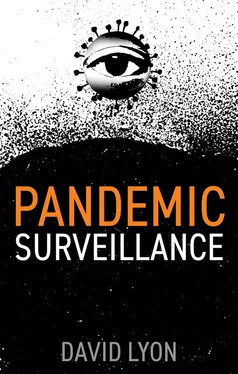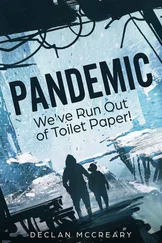So, what is meant by “surveillance?” According to the World Health Organization (WHO), surveillance in relation to public health is the “ongoing, systematic collection, analysis and interpretation of health-related data essential to the planning, implementation and evaluation of public health practice.” 3It is undertaken to inform disease prevention and control measures. Understood this way, it has clear human benefit and should thus be a priority among the available tools for confronting a pandemic, especially a global one. As we shall see, however, the WHO also notes the social and other dimensions of such surveillance, and warns that surveillance tools are not neutral and may be used in ways that challenge other priorities such as human rights and civil liberties.
More generally, we may think of surveillance as any purposeful, focused, systematic and routine observation and attention to personal details. Those “personal details” are sought, today, in digital data, made available in multiple formats that can snowball in some contexts. For instance, the data for contact tracing depends on location-tracking possibilities embedded in the smartphone. If, say, police obtain access to the public health data, as has occurred in several places, including Singapore, the same data could be used for crime investigations as well as contagion control.
In the case of public health surveillance, then, the purposes are those mentioned by the WHO: disease prevention and control. Inevitably, this also includes control of people – who and where they are, who they are with and how close, physically. Another way of thinking about this is to say that surveillance occurs to make people visible in specific ways, then to represent them in those ways so that they can be treated appropriately for whatever purposes the surveillor has in mind. Thus, what sorts of data are collected, how they are analyzed, and what assessments and judgments are made from them are matters of moment – especially as the data is so sensitive, touching on matters of health and the body.
Public health data, then, might make people visible in terms of their relative ages – elderly people are generally more likely to become seriously ill or die if they contract COVID-19, for instance – or where they live – postcodes are often used as proxy for lifestyles by any and all of police, marketers and healthcare scientists – so that testing or vaccines can be targeted appropriately. Equally, public health agencies may wish to know who has been in contact with infected people, or whether those people are isolating or quarantining themselves, and surveillance may be sought for that quest.
Of course, several of these schemes turned out to be quite controversial, whether used for contact tracing or quarantine-policing or, on a large scale, for monitoring the progress of the mutating virus through large populations. Understandably, it is smartphone apps or wearables such as wristbands that directly affect individuals which raise most concern. For instance, a cluster of gay men was “outed” in South Korea when a number of COVID-19 cases came to light in a Seoul district well known for its gay bars. Also, a Minnesota law official appeared to claim that the state was using “contact tracing” to identify connections between Black Lives Matter protesters in May 2020. 4But often the technologies used for surveillance have effects that are hard to discern by those whose data is in use, not least because their impact may be indirect.
As an example, in February 2020, South Korean citizens found that the government was publishing on websites and in texts the details of the exact movements of unidentified individuals for all COVID-19 cases. One could read, “Patient No. 12 had booked Seats E13 and E14 for a 5:30 pm showing of the South Korean film, ‘The Man Standing Next.’ Before grabbing a 12:40 pm train, patient No. 17 dined at a soft-tofu restaurant in Seoul.” 5Doubtless, the aim was to see whether undiscovered contacts could be traced and tested. But such data, in the wrong hands, could also be misused.
As well, cultural differences are significant – seen also, for instance, in the willingness to wear masks in public – in relation to allowing authorities to think that they can impose certain behavioral requirements or post personal details publicly. How people respond – for instance, by stigmatizing or even attacking those who fail to wear masks or who appear to have been contagion carriers – is another matter.
Although the H1N1 pandemic occurred in a world of information technology, the COVID-19 pandemic was the first to occur in a context of surveillance capitalism, 6and this is crucially important. So-called Big Data had made its appearance in the early years of the twenty-first century, prompted by developments in distributed computing, data analytics and statistics. But its value for commerce, especially in rapidly expanding platform companies, following its signal success for Google and then several social media giants, was unprecedented.
Surveillance capitalism had discovered how to make profit from apparently inconsequential data exuded by these platforms, prompted by everyday users of platforms like Facebook and WeChat. But, crucially, that data could also be repurposed by, for example, police and security agencies. Governments found ways of using that data, too, and often sought to attract those large corporations to set up shop in their countries. An example is the attempt by Alphabet, Google’s parent company, to plant a smart city in Toronto – “Sidewalk Labs.” 7The “smartness” lay in the data-dependence of the project, a high-tech “utopia” with sensors embedded everywhere. As the Atlantic put it, “The city is literally built to collect data about its residents and visitors.” 8The plan was aborted during the pandemic in May 2020.
It is clear that platforms were seeking yet other openings for obtaining valuable – and sensitive – data. Google’s Deep Mind, an Artificial Intelligence (AI) company, built an app called Streams, for example, to give alerts to people with kidney injuries. But the Royal Free London National Health Service (NHS) Foundation Trust gifted 1.6 million patient-identifiable records to it in 2015, an act that contravened four data protection principles enshrined in British law, not to mention patient confidentiality. 9It shows that platforms are keen to get their hands on such sensitive data and that some government-related bodies – in this case, the UK’s NHS – seem willing to embed the likes of a Google subsidiary within their system, apparently without precautions.
Well before the pandemic, governments in many countries realized that they did not have the capacity to develop technologies deemed “necessary” for a digital era. Leaders such as IBM or some enterprising start-ups would engineer advances and then make agreements with governments. The Apple–Google collaboration, which followed this model, centered on an API – Application Programming Interface – that allows two applications to “talk” to each other. Used in several digital tracking apps for contact tracing, it does rely on “Privacy-Preserving” protocols, but this in itself does not mean that platforms such as Google would not like to obtain access to health data. As would governments. Contact tracing apps provide another government-sanctioned reason to have your phone send data over networks. This means more time-on-device which, as Shoshana Zuboff shows, is the raw material for platform companies.
The pandemic arrived in a context where (big) data was already prized for its apparent value in providing “solutions” in many areas of life, including in government. This is clear in other aspects of the pandemic context besides health and medicine. As lockdowns occurred, businesses, schools, stores – and doctors’ offices, for that matter – went remote. There was a sudden massive demand for technology platform companies to continue work and education online. Zoom and others went into a boom phase, from 10 to 300 million users per day, between December 2019 and June 2020. Millions of people who were otherwise isolated from friends and family were thankful for the many video communication platforms that at least offered a chance for electronic connection. Surveillance capitalism – profiting from user attention data – was in its ascendance when the pandemic hit. The pandemic is a multi-faceted phenomenon.
Читать дальше












